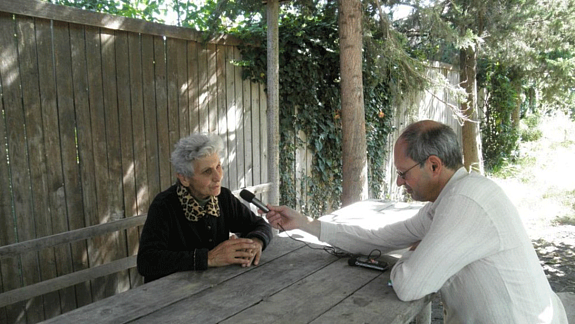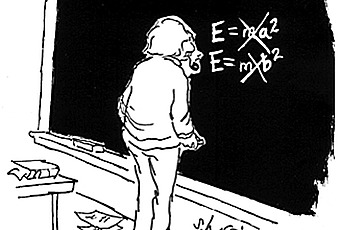Aramaic and Endangered Languages

I had the privilege of being a Member at the Institute for Advanced Study from January to April 2015, during which my main research project concerned a corpus of Arabic documents from medieval Nubia. I had the opportunity to make a presentation at the Institute’s informal “After Hours” gatherings about another field of research I have been working on for the last twenty years or so, namely endangered Aramaic dialects.
For my academic degrees at the University of London (School of Oriental and African Studies), I studied the classical Semitic languages, in particular the classical written forms of Arabic, Hebrew, and Aramaic, and went on to take up a postdoctoral position on a project on medieval Arabic and Hebrew manuscripts at the University of Cambridge. Some years later, I spent a year off from my postdoctoral job in Jerusalem, where I planned to spend most of my time reading microfilms of medieval manuscripts. While buying vegetables in the market one day, I heard the owner of the stall speaking a language that turned out to be a dialect of Aramaic. This whetted my appetite and I subsequently arranged to meet an elderly man who spoke Aramaic in his small apartment in the area of Jerusalem known as Qatamon. This meeting turned out to be a life-changing experience for me. I realized on that day that I was sitting in front of one of the last surviving speakers of a dialect of Aramaic. Aramaic was one of the major languages of the ancient Near East. Since the Middle Ages it has largely been replaced by Arabic, but it survived as a spoken language in a number of Jewish communities in the mountainous regions of northern Iraq, south-eastern Turkey, and western Iran down to modern times. Spoken Aramaic also survived to modern times among Christian communities in the same regions and also in a few villages in Syria. Over one hundred dialects of Aramaic were spoken in the Middle East in the first half of the twentieth century. The Jews adopted Aramaic when they were exiled to Mesopotamia in antiquity by the Babylonians, and some remained there. What I was hearing that day were the surviving cadences of the language of the ancient Jewish exile.
In the second half of the twentieth century, virtually all the Aramaic-speaking Jews settled in the State of Israel, and their children and grandchildren adopted modern Hebrew as their spoken language. As a result, Aramaic is now spoken by only a very few elderly people. Some dialects have now been reduced to a single final speaker or have already become extinct. The same fate has befallen a large proportion of the Christian dialects, as a result of the fact that many of the Aramaic-speaking Christians have left the Middle East, mainly during periods of political and social upheaval. The major upheaval for the Christian communities was World War I, during which thousands of Aramaic speakers were displaced or lost their lives. This displacement from their native villages is still taking place as I write, due to the atrocities that are unfolding in northern Iraq and Syria. All of this means that Aramaic is now an endangered language.
Sadly, many languages in the world are currently experiencing the same fate as Aramaic and are now endangered. The statistics are frightening. Some estimate that as much as 90 percent of the languages that are currently spoken will be extinct by the end of this century. This is vastly greater than extinction rates of biological species (currently 7 percent of mammals and 3 percent of birds in the worst-case scenario). A language becomes endangered when it has only a few elderly surviving speakers and is not spoken by younger generations. Since the majority of the world’s languages have no written tradition, most such endangered languages are doomed to extinction and oblivion. The threat of extinction even extends to many of the major languages of the modern world, since these languages have many spoken dialectal varieties, and some of these varieties are now endangered, such as Central Asian and Judeo–Arabic dialects, Cappadocian Greek, Guernsey Norman French, and many dialects of English.
Why are so many languages endangered? Four main causes can be identified: (i) the displacement of communities, due to violent upheavals in war or economic migration to towns, (ii) the dominance of national standard languages in modern nation states, (iii) the impact of education and media in standard languages, and (iv) a negative attitude to ancestral languages. All of these factors have affected the fate of Aramaic.
What needs to be done about it? In some cases there is still a possibility that an endangered language can be saved by a concerted program of revitalization through education involving teachers from within the language communities. Such revitalization is, however, very difficult and the eventual extinction of the majority of the world’s endangered languages is inevitable. The most important task for a linguist, therefore, is to carry out a systematic documentation of endangered languages through fieldwork in the communities. This is what I have been attempting to do for Aramaic over the last twenty years. Most of my fieldwork has been among the diaspora Jewish and Christian communities of Aramaic speakers around the world. In some cases, I have interviewed the final speaker of a dialect.
Unfortunately, final speakers are often physically frail and decrepit, and this can complicate fieldwork. It is common for elderly speakers to be lacking in teeth, which wipes out all their dental and interdental consonants. One final speaker I met in New Zealand turned out to have a lisp, which complicated the reconstruction of the original phonology of the dialect. Some years ago, I tried to work with the last speaker of a Jewish dialect in Israel, an elderly woman in her 90s, who could only breathe with a ventilator and could only give me single words as answers to my questions—sentences required too much breath. The speakers I have worked with have generally been very hospitable. Too much hospitality, however, can lead to complications. Some years ago I tried to work with a community of Aramaic speakers in Armenia, but every time I visited them they insisted on honoring me with a series of toasts of vodka before they answered my questions. It is not clear, therefore, whether the various losses of consonants and contractions in my recordings of their dialect are due to diachronic linguistic development or the influence of their hospitality. Occasionally I have had the opposite experience and been treated with fear and suspicion. One elderly lady in Tbilisi set her Rottweilers on me when I tried to interview her in her home.
Why should we care about the extinction of languages? There are numerous reasons why we should be concerned about the loss of languages. Some of these are as follows.
- Language diversity is a reflection of human diversity and this can be regarded as important as ecological diversity.
- Every language and every dialect within a language is unique and reflects distinct aspects of human language in general. So loss of language diversity is an impoverishment of human language and diminishes opportunities for us to study the full potential of human language, arguably the most important manifestation of humanity.
- When a language of a community dies, many aspects of culture are lost, in particular traditions of oral literature that have been passed down for generations.
- A language contains history. This is found in oral traditions of a community’s history and also in its oral literature. Some of the stories of the Greek myths, for example, have survived in the Aramaic-speaking communities (with all the names of characters changed). A language also contains history within its own linguistic structure. The study of the oral literature and the language structure can tell us a lot about the historical background of the community, which may not have any written historical records.


